gas type VOLVO XC60 TWIN ENGINE 2019 Owners Manual
[x] Cancel search | Manufacturer: VOLVO, Model Year: 2019, Model line: XC60 TWIN ENGINE, Model: VOLVO XC60 TWIN ENGINE 2019Pages: 695, PDF Size: 14.96 MB
Page 10 of 695

8
Pilot Assist limitations323
Pilot Assist* symbols and messages324
Radar sensor326
Radar sensor limitations327
Recommended maintenance for theradar sensor330
Radar sensor type approval330
Camera331
Camera limitations332
Recommended maintenance for thecamera/radar sensor335
City Safety™335
City Safety parameters and sub-functions336
Setting a warning distance for City Safety338
Detecting obstacles with City Safety339
City Safety in crossing traffic341
Limitations of City Safety in crossingtraffic342
City Safety steering assistance forevasive maneuver343
City Safety steering assistance limi-tations during evasive maneuvers343
City Safety and delayed evasivemaneuvers344
City Safety braking for oncomingvehicles*345
City Safety limitations346
City Safety messages348
Rear Collision Warning349
Rear Collision Warning limitations349
BLIS*350
Activating/deactivating BLIS351
BLIS limitations352
Recommended maintenance for BLIS353
BLIS messages354
Cross Traffic Alert*355
Activating/deactivating Cross TrafficAlert356
Cross Traffic Alert limitations356
Recommended maintenance forCross Traffic Alert357
Cross Traffic Alert messages358
Road Sign Information*359
Activating/deactivating Road SignInformation360
Road Sign Information and sign displays361
Road Sign Information and SensusNavigation361
Road Sign Information with SpeedWarning and Settings362
Activating/deactivating Speed Warn-ing in Road Sign Information363
Road Sign Information with speedcamera information363
Road Sign Information limitations364
Driver Alert Control365
Activating/deactivating Driver AlertControl366
Selecting guidance to a rest area ifthe Driver Alert Control warning hasbeen given
367
Driver Alert Control limitations367
Lane Keeping Aid367
Steering assistance with Lane Keep-ing Aid369
Activating/deactivating Lane Keeping Aid370
Selecting type of assistance for LaneKeeping Aid370
Lane Keeping Aid limitations371
Lane Keeping Aid symbols and mes-sages372
Lane Keeping Aid symbols in theinstrument panel374
Steering assistance at risk of collision375
Activating/deactivating steeringassistance during collision risks375
Run-Off Mitigation with steeringassistance376
Run-Off Mitigation with steeringassistance levels376
Activating/deactivating Run-Off Miti-gation with steering assistance377
Page 11 of 695
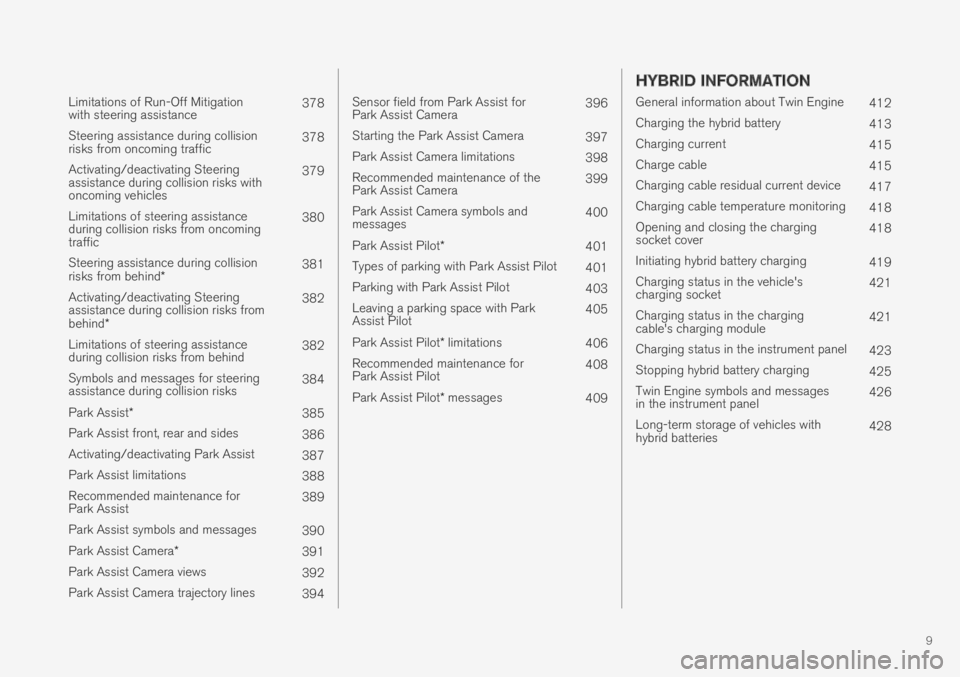
9
Limitations of Run-Off Mitigationwith steering assistance378
Steering assistance during collisionrisks from oncoming traffic378
Activating/deactivating Steeringassistance during collision risks withoncoming vehicles
379
Limitations of steering assistanceduring collision risks from oncomingtraffic
380
Steering assistance during collisionrisks from behind*381
Activating/deactivating Steeringassistance during collision risks frombehind*
382
Limitations of steering assistanceduring collision risks from behind382
Symbols and messages for steeringassistance during collision risks384
Park Assist*385
Park Assist front, rear and sides386
Activating/deactivating Park Assist387
Park Assist limitations388
Recommended maintenance forPark Assist389
Park Assist symbols and messages390
Park Assist Camera*391
Park Assist Camera views392
Park Assist Camera trajectory lines394
Sensor field from Park Assist forPark Assist Camera396
Starting the Park Assist Camera397
Park Assist Camera limitations398
Recommended maintenance of thePark Assist Camera399
Park Assist Camera symbols andmessages400
Park Assist Pilot* 401
Types of parking with Park Assist Pilot401
Parking with Park Assist Pilot403
Leaving a parking space with ParkAssist Pilot405
Park Assist Pilot* limitations 406
Recommended maintenance forPark Assist Pilot408
Park Assist Pilot* messages409
HYBRID INFORMATION
General information about Twin Engine412
Charging the hybrid battery413
Charging current415
Charge cable415
Charging cable residual current device417
Charging cable temperature monitoring418
Opening and closing the chargingsocket cover418
Initiating hybrid battery charging419
Charging status in the vehicle'scharging socket421
Charging status in the chargingcable's charging module421
Charging status in the instrument panel423
Stopping hybrid battery charging425
Twin Engine symbols and messagesin the instrument panel426
Long-term storage of vehicles withhybrid batteries428
Page 306 of 695

DRIVER SUPPORT
* Option/accessory.304
Starting passing assistance withAdaptive Cruise Control
Several conditions must be met for passingassistance to be possible.
Requirements for passing assistance
In order to activate passing assistance:
your vehicle must be following a vehicleahead (target vehicle)
your vehicle's current speed must beat least 70 km/h (43 mph)
the set speed for ACC must be highenough to safely pass another vehicle.
Starting parking assistance
To start passing assistance:
–Turn on the left turn signal.
>Passing assistance will start.
Related information
Adaptive Cruise Control* (p. 294)
Passing assistance with Adaptive CruiseControl (p. 303)
Limitations of passing assistancewith Adaptive Cruise Control
Passing assistance functionality may be reducedin certain situations.
WARNING
The driver should be aware that if conditionssuddenly change when using Parking Assis-tance, the function may implement an unde-sired acceleration in certain conditions.
Some situations should be avoided, e.g. if:
the vehicle is approaching an exit in thesame direction as passing would normallyoccur
the vehicle ahead slows before your vehi-cle has had time to switch to the passinglane
traffic in the passing lane slows down
a vehicle for right-hand traffic is driven ina country with left-hand traffic (or viceversa).
Situations of this type can be avoided by tempo-
rarily putting ACC49 in standby mode.
Related information
Adaptive Cruise Control* (p. 294)
Passing assistance with Adaptive CruiseControl (p. 303)
Switching target vehicles withAdaptive Cruise Control
At certain speeds, models with automatic trans-
missions and Adaptive Cruise Control (ACC50)can switch target vehicles.
Switching target vehicles
If the target vehicle ahead turns suddenly, there may bestationary traffic ahead.
When Adaptive Cruise Control is actively follow-ing another vehicle at speeds under 30 km/h(20 mph) and switches targets from a movingvehicle to a stationary vehicle, Adaptive CruiseControl will brake for the stationary vehicle.
49Adaptive Cruise Control
Page 323 of 695
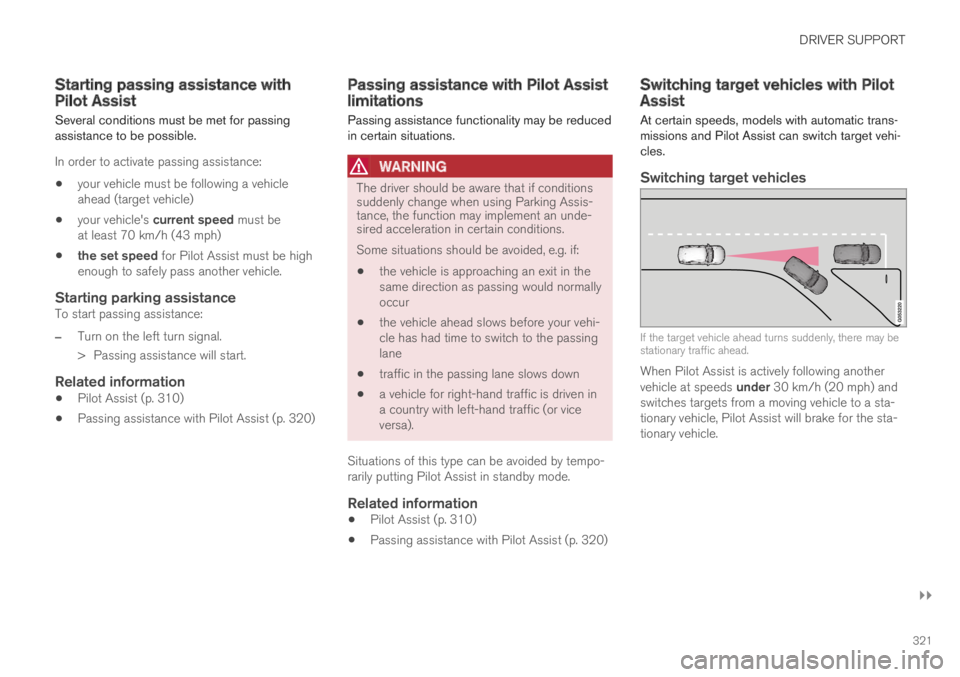
DRIVER SUPPORT
}}
321
Starting passing assistance withPilot Assist
Several conditions must be met for passingassistance to be possible.
In order to activate passing assistance:
your vehicle must be following a vehicleahead (target vehicle)
your vehicle's current speed must beat least 70 km/h (43 mph)
the set speed for Pilot Assist must be highenough to safely pass another vehicle.
Starting parking assistance
To start passing assistance:
–Turn on the left turn signal.
>Passing assistance will start.
Related information
Pilot Assist (p. 310)
Passing assistance with Pilot Assist (p. 320)
Passing assistance with Pilot Assistlimitations
Passing assistance functionality may be reducedin certain situations.
WARNING
The driver should be aware that if conditionssuddenly change when using Parking Assis-tance, the function may implement an unde-sired acceleration in certain conditions.
Some situations should be avoided, e.g. if:
the vehicle is approaching an exit in thesame direction as passing would normallyoccur
the vehicle ahead slows before your vehi-cle has had time to switch to the passinglane
traffic in the passing lane slows down
a vehicle for right-hand traffic is driven ina country with left-hand traffic (or viceversa).
Situations of this type can be avoided by tempo-rarily putting Pilot Assist in standby mode.
Related information
Pilot Assist (p. 310)
Passing assistance with Pilot Assist (p. 320)
Switching target vehicles with PilotAssist
At certain speeds, models with automatic trans-missions and Pilot Assist can switch target vehi-cles.
Switching target vehicles
If the target vehicle ahead turns suddenly, there may bestationary traffic ahead.
When Pilot Assist is actively following anothervehicle at speeds under 30 km/h (20 mph) andswitches targets from a moving vehicle to a sta-tionary vehicle, Pilot Assist will brake for the sta-tionary vehicle.
Page 372 of 695
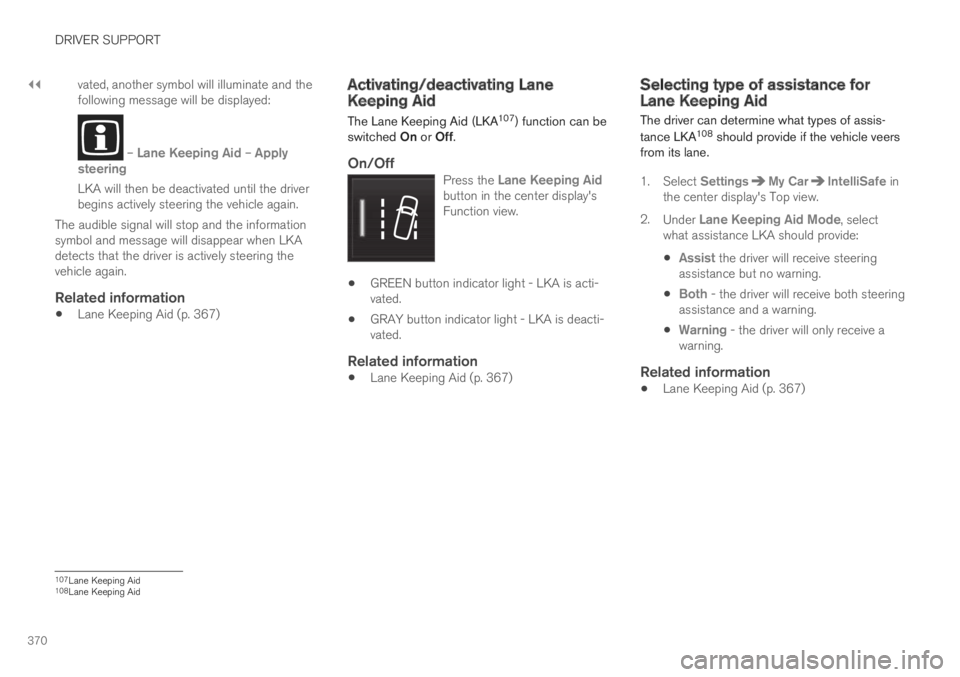
||
DRIVER SUPPORT
370
vated, another symbol will illuminate and thefollowing message will be displayed:
– Lane Keeping Aid – Applysteering
LKA will then be deactivated until the driverbegins actively steering the vehicle again.
The audible signal will stop and the informationsymbol and message will disappear when LKAdetects that the driver is actively steering thevehicle again.
Related information
Lane Keeping Aid (p. 367)
Activating/deactivating LaneKeeping Aid
The Lane Keeping Aid (LKA107) function can beswitched On or Off.
On/Off
Press the Lane Keeping Aidbutton in the center display'sFunction view.
GREEN button indicator light - LKA is acti-vated.
GRAY button indicator light - LKA is deacti-vated.
Related information
Lane Keeping Aid (p. 367)
Selecting type of assistance forLane Keeping Aid
The driver can determine what types of assis-
tance LKA108 should provide if the vehicle veersfrom its lane.
1. Select SettingsMy CarIntelliSafe inthe center display's Top view.
2.Under Lane Keeping Aid Mode, selectwhat assistance LKA should provide:
Assist the driver will receive steeringassistance but no warning.
Both - the driver will receive both steeringassistance and a warning.
Warning - the driver will only receive awarning.
Related information
Lane Keeping Aid (p. 367)
107Lane Keeping Aid108Lane Keeping Aid
Page 432 of 695
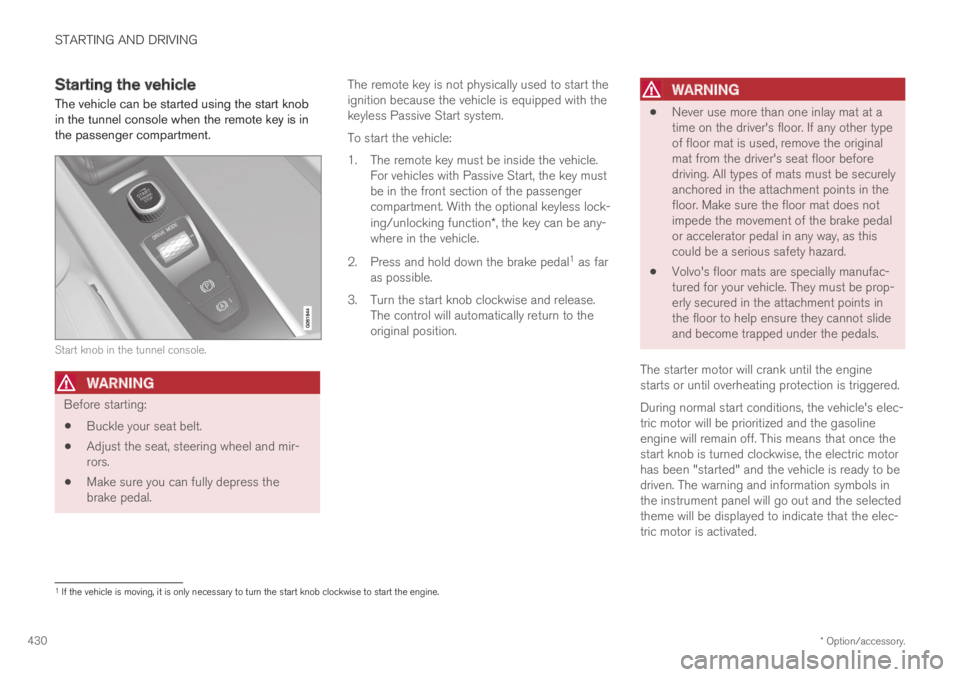
STARTING AND DRIVING
* Option/accessory.430
Starting the vehicle
The vehicle can be started using the start knobin the tunnel console when the remote key is inthe passenger compartment.
Start knob in the tunnel console.
WARNING
Before starting:
Buckle your seat belt.
Adjust the seat, steering wheel and mir-rors.
Make sure you can fully depress thebrake pedal.
The remote key is not physically used to start theignition because the vehicle is equipped with thekeyless Passive Start system.
To start the vehicle:
1.The remote key must be inside the vehicle.For vehicles with Passive Start, the key mustbe in the front section of the passengercompartment. With the optional keyless lock-ing/unlocking function*, the key can be any-where in the vehicle.
2. Press and hold down the brake pedal1 as faras possible.
3. Turn the start knob clockwise and release.The control will automatically return to theoriginal position.
WARNING
Never use more than one inlay mat at atime on the driver's floor. If any other typeof floor mat is used, remove the originalmat from the driver's seat floor beforedriving. All types of mats must be securelyanchored in the attachment points in thefloor. Make sure the floor mat does notimpede the movement of the brake pedalor accelerator pedal in any way, as thiscould be a serious safety hazard.
Volvo's floor mats are specially manufac-tured for your vehicle. They must be prop-erly secured in the attachment points inthe floor to help ensure they cannot slideand become trapped under the pedals.
The starter motor will crank until the enginestarts or until overheating protection is triggered.
During normal start conditions, the vehicle's elec-tric motor will be prioritized and the gasolineengine will remain off. This means that once thestart knob is turned clockwise, the electric motorhas been "started" and the vehicle is ready to bedriven. The warning and information symbols inthe instrument panel will go out and the selectedtheme will be displayed to indicate that the elec-tric motor is activated.
1If the vehicle is moving, it is only necessary to turn the start knob clockwise to start the engine.
Page 433 of 695
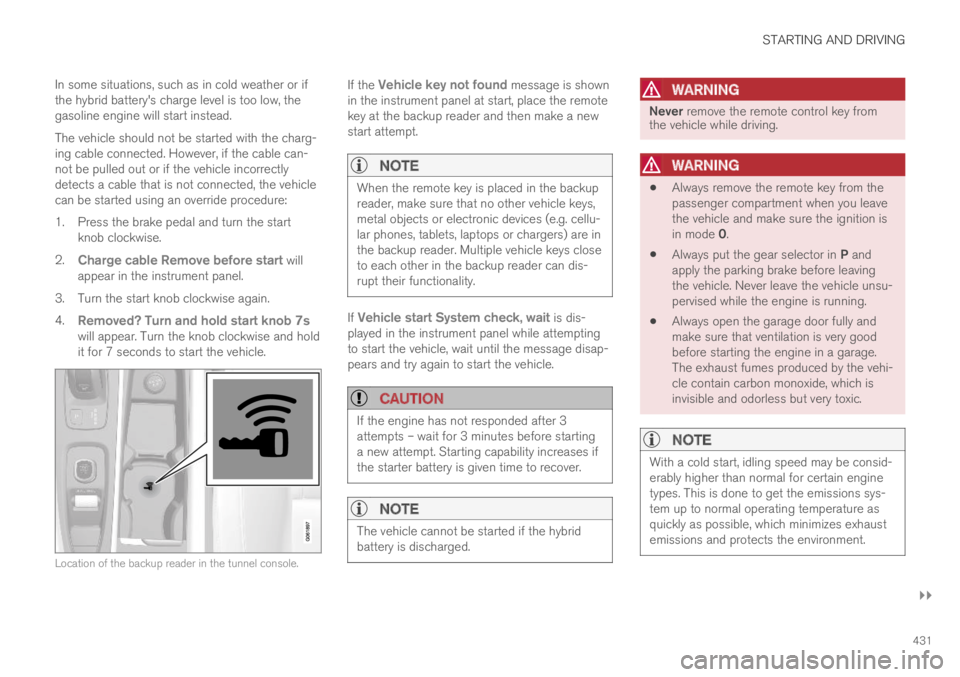
STARTING AND DRIVING
}}
431
In some situations, such as in cold weather or ifthe hybrid battery's charge level is too low, thegasoline engine will start instead.
The vehicle should not be started with the charg-ing cable connected. However, if the cable can-not be pulled out or if the vehicle incorrectlydetects a cable that is not connected, the vehiclecan be started using an override procedure:
1.Press the brake pedal and turn the startknob clockwise.
2.Charge cable Remove before start willappear in the instrument panel.
3.Turn the start knob clockwise again.
4.Removed? Turn and hold start knob 7swill appear. Turn the knob clockwise and holdit for 7 seconds to start the vehicle.
Location of the backup reader in the tunnel console.
If the Vehicle key not found message is shownin the instrument panel at start, place the remotekey at the backup reader and then make a newstart attempt.
NOTE
When the remote key is placed in the backupreader, make sure that no other vehicle keys,metal objects or electronic devices (e.g. cellu-lar phones, tablets, laptops or chargers) are inthe backup reader. Multiple vehicle keys closeto each other in the backup reader can dis-rupt their functionality.
If Vehicle start System check, wait is dis-played in the instrument panel while attemptingto start the vehicle, wait until the message disap-pears and try again to start the vehicle.
CAUTION
If the engine has not responded after 3attempts – wait for 3 minutes before startinga new attempt. Starting capability increases ifthe starter battery is given time to recover.
NOTE
The vehicle cannot be started if the hybridbattery is discharged.
WARNING
Never remove the remote control key fromthe vehicle while driving.
WARNING
Always remove the remote key from thepassenger compartment when you leavethe vehicle and make sure the ignition isin mode 0.
Always put the gear selector in P andapply the parking brake before leavingthe vehicle. Never leave the vehicle unsu-pervised while the engine is running.
Always open the garage door fully andmake sure that ventilation is very goodbefore starting the engine in a garage.The exhaust fumes produced by the vehi-cle contain carbon monoxide, which isinvisible and odorless but very toxic.
NOTE
With a cold start, idling speed may be consid-erably higher than normal for certain enginetypes. This is done to get the emissions sys-tem up to normal operating temperature asquickly as possible, which minimizes exhaustemissions and protects the environment.
Page 514 of 695

AUDIO, MEDIA AND INTERNET
* Option/accessory.512
SiriusXM Travel Link®* - Fuel5
This SiriusXM Travel Link service provides infor-mation and guidance to service stations near thevehicle providing the type of fuel that you prefer/require for your vehicle.
From the SiriusXM Travel Link home screen, toshow fuel information:
–Tap the Fuel button to display the main fuelscreen.
The following categories are shown:
Search (the magnifying glass icon)
Nearby
Recommended
Favorites
Brands
Tap one of the alternatives to display its screen.
NOTE
In each of the categories listed, tapping theSelect fuel type button near the bottom ofthe screen opens a sub-view where you canspecify the type of fuel preferred/required(Regular, Midrange, Premium, Diesel,Electric 120V, etc.) Tap Done to return tothe previous screen.
Search
Tap the magnifying glass icon. If the function issupported in the current context, a keyboard willappear on the screen. Enter the text of yourchoice and tap Search for detailed information ifavailable.
Nearby
Tap for a list of service stations in the vicinity ofthe vehicle, with the nearest station at the top ofthe list.
The following information will be provided whereavailable:
For vehicles using gasoline, the price infor-mation for regular gasoline (unless anothergrade/type of fuel has been selected inSelect fuel type)
For electric vehicles/hybrids, informationabout charging stations, showing the totalnumber of charging ports and the number ofports currently not in use
the distance to the station
a star icon to set the service station as afavorite
Tap the name of a service station to display moredetailed information.
For guidance to the service station, tap the Startnavigation or Add as waypoint buttons. See
the Sensus Navigation* supplement for additionalinformation about using the navigation system.
Recommended
Tap for a list of service stations near the vehicle,displayed according to the price of regular gaso-line (unless another grade/type of fuel has beenselected in Select fuel type) or of stationsoffering the greatest number of available charg-ing ports for electric vehicles/hybrids. The stationoffering the lowest price/most available chargingports will be displayed at the top of the list. Tapthe name of a service station to display moredetailed information.
Favorites
Tap for a list of service stations that have beenstored as favorites. Tap the name of a servicestation to display more detailed information.
In addition to the Select fuel type button at thebottom of the screen, tap the Edit button todelete individual stations from the list or tapDelete to clear the list. Tap Done to return tothe previous screen.
Brands
1.Tap Brands to display a list of service sta-tion brands in the area.
5This service is not available in Canada.
Page 671 of 695
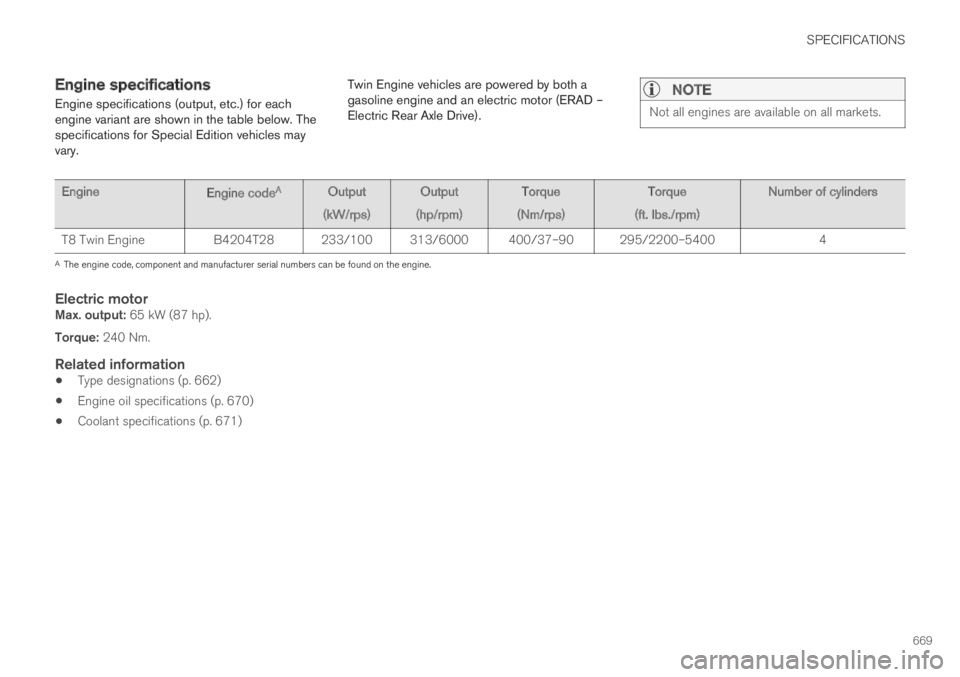
SPECIFICATIONS
669
Engine specifications
Engine specifications (output, etc.) for eachengine variant are shown in the table below. Thespecifications for Special Edition vehicles mayvary.
Twin Engine vehicles are powered by both agasoline engine and an electric motor (ERAD –Electric Rear Axle Drive).
NOTE
Not all engines are available on all markets.
EngineEngine codeAOutput
(kW/rps)
Output
(hp/rpm)
Torque
(Nm/rps)
Torque
(ft. lbs./rpm)
Number of cylinders
T8 Twin EngineB4204T28 233/100 313/6000 400/37–90 295/2200–54004
AThe engine code, component and manufacturer serial numbers can be found on the engine.
Electric motor
Max. output: 65 kW (87 hp).
Torque: 240 Nm.
Related information
Type designations (p. 662)
Engine oil specifications (p. 670)
Coolant specifications (p. 671)